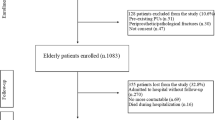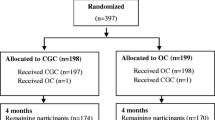Abstract
Introduction
Geriatric hip fracture patients are a highly heterogeneous collective, what distinctly aggravates the best possible treatment. Consequently, it is becoming more important to identify selection criteria that can distinguish those patients who can benefit the most from treatment in a geriatric fracture center. In our pilot study, we assessed the 2007 published Penrod score for its utility as a useful selection tool by prospectively comparing our own patient’s outcome with the Penrod study.
Methods
77 patients treated for geriatric hip fracture were preoperatively classified according to the Penrod score. Patients were divided into three clusters by age (1: <75 years, 2: 75–84 years, 3: ≥85 years). Clusters 2 and 3 were then classified according to their ability to perform activities of daily living (ADL’s) and cognitive status (presence or absence of dementia). In 51 out of these 77 patients, the ability to perform ADLs could be assessed 6 months postoperatively and was compared with the Penrod scores.
Results
58 % of cluster 1 patients were able to perform 4 ADLs independently 6 months postoperatively (52.9 % Penrod study). In clusters 2A and 3A, 48 and 50 %, respectively, were able to perform 4 ADLs independently, compared with 40.6 and 31.5 % (Penrod collective). 22 % of our patients in 2B performed all ADLs independently (3.6 % Penrod) and 25 % in cluster 3B (9.4 % Penrod).
Conclusion
Our preliminary results support the prognostic value of the Penrod score in the treatment of geriatric hip fracture patients. With the help of the Penrod score, it may be possible to identify patients, who are expected to significantly profit from an intensified treatment in a geriatric fracture center (clusters 2B, 3A, and 3B). By utilizing this score, improved outcomes and simultaneously a more effective utilization of valuable health care resources could be achieved.

Similar content being viewed by others
References
Saltzherr TP, Borghans HJ, Bakker RH, Go PM (2006) Proximal femur fractures in the elderly in The Netherlands during the period 1991–2004: incidence, mortality, length of hospital stay and an estimate of the care capacity needed in the future. Ned Tijdschr Geneeskd 150(47):2599–2604
Svedbom A, Ivergard M, Hernlund E, Rizzoli R, Kanis JA (2014) Epidemiology and economic burden of osteoporosis in Switzerland. Arch Osteoporos 9:187. doi:10.1007/s11657-014-0187-y
Leibson CL, Tosteson AN, Gabriel SE, Ransom JE, Melton LJ (2002) Mortality, disability, and nursing home use for persons with and without hip fracture: a population-based study. J Am Geriatr Soc 50(10):1644–1650
Farahmand BY, Michaelsson K, Ahlbom A, Ljunghall S, Baron JA, Swedish Hip Fracture Study G (2005) Survival after hip fracture. Osteoporos Int 16 (12):1583–1590. doi:10.1007/s00198-005-2024-z
Cannada LK, Hill BW (2014) Osteoporotic hip and spine fractures: a current review. Geriatr Orthop Surg Rehabil 5(4):207–212. doi:10.1177/2151458514548579
Magaziner J, Hawkes W, Hebel JR, Zimmerman SI, Fox KM, Dolan M, Felsenthal G, Kenzora J (2000) Recovery from hip fracture in eight areas of function. J Gerontol A Biol Sci Med Sci 55(9):M498–M507
Bonar SK, Tinetti ME, Speechley M, Cooney LM (1990) Factors associated with short- versus long-term skilled nursing facility placement among community-living hip fracture patients. J Am Geriatr Soc 38(10):1139–1144
Gonzalez-Zabaleta J, Pita-Fernandez S, Seoane-Pillado T, Lopez-Calvino B, Gonzalez-Zabaleta JL (2015) Comorbidity as a predictor of mortality and mobility after hip fracture. Geriatr Gerontol Int. doi:10.1111/ggi.12510
Penrod JD, Litke A, Hawkes WG, Magaziner J, Doucette JT, Koval KJ, Silberzweig SB, Egol KA, Siu AL (2008) The association of race, gender, and comorbidity with mortality and function after hip fracture. J Gerontol A Biol Sci Med Sci 63(8):867–872
Smith T, Pelpola K, Ball M, Ong A, Myint PK (2014) Pre-operative indicators for mortality following hip fracture surgery: a systematic review and meta-analysis. Age Ageing 43(4):464–471. doi:10.1093/ageing/afu065
Friedman SM, Mendelson DA, Bingham KW, Kates SL (2009) Impact of a comanaged Geriatric Fracture Center on short-term hip fracture outcomes. Arch Intern Med 169(18):1712–1717. doi:10.1001/archinternmed.2009.321
Mendelson DA, Friedman SM (2014) Principles of comanagement and the geriatric fracture center. Clin Geriatr Med 30(2):183–189. doi:10.1016/j.cger.2014.01.016
Suhm N, Kaelin R, Studer P, Wang Q, Kressig RW, Rikli D, Jakob M, Pretto M (2014) Orthogeriatric care pathway: a prospective survey of impact on length of stay, mortality and institutionalisation. Arch Orthop Trauma Surg 134(9):1261–1269. doi:10.1007/s00402-014-2057-x
Penrod JD, Litke A, Hawkes WG, Magaziner J, Koval KJ, Doucette JT, Silberzweig SB, Siu AL (2007) Heterogeneity in hip fracture patients: age, functional status, and comorbidity. J Am Geriatr Soc 55(3):407–413. doi:10.1111/j.1532-5415.2007.01078.x
Hannan EL, Magaziner J, Wang JJ, Eastwood EA, Silberzweig SB, Gilbert M, Morrison RS, McLaughlin MA, Orosz GM, Siu AL (2001) Mortality and locomotion 6 months after hospitalization for hip fracture: risk factors and risk-adjusted hospital outcomes. JAMA 285(21):2736–2742
Suhm N, Rikli D, Schaeren S, Studer P, Jakob M, Kates SL (2010) Recent aspects on outcomes in geriatric fracture patients. Osteoporos Int 21(Suppl 4):S523–S528. doi:10.1007/s00198-010-1397-9
Merten H, Johannesma PC, Lubberding S, Zegers M, Langelaan M, Jukema GN, Heetveld MJ, Wagner C (2015) High risk of adverse events in hospitalised hip fracture patients of 65 years and older: results of a retrospective record review study. BMJ Open 5(9):e006663. doi:10.1136/bmjopen-2014-006663
Bellelli G, Mazzola P, Morandi A, Bruni A, Carnevali L, Corsi M, Zatti G, Zambon A, Corrao G, Olofsson B, Gustafson Y, Annoni G (2014) Duration of postoperative delirium is an independent predictor of 6-month mortality in older adults after hip fracture. J Am Geriatr Soc 62(7):1335–1340. doi:10.1111/jgs.12885
Prestmo A, Hagen G, Sletvold O, Helbostad JL, Thingstad P, Taraldsen K, Lydersen S, Halsteinli V, Saltnes T, Lamb SE, Johnsen LG, Saltvedt I (2015) Comprehensive geriatric care for patients with hip fractures: a prospective, randomised, controlled trial. Lancet 385(9978):1623–1633. doi:10.1016/S0140-6736(14)62409-0
Koval KJ, Skovron ML, Aharonoff GB, Zuckerman JD (1998) Predictors of functional recovery after hip fracture in the elderly. Clin Orthop Relat Res 348:22–28
Magaziner J, Simonsick EM, Kashner TM, Hebel JR, Kenzora JE (1990) Predictors of functional recovery 1 year following hospital discharge for hip fracture: a prospective study. J Gerontol 45(3):M101–M107
Hernlund E, Svedbom A, Ivergard M, Compston J, Cooper C, Stenmark J, McCloskey EV, Jonsson B, Kanis JA (2013) Osteoporosis in the European Union: medical management, epidemiology and economic burden. A report prepared in collaboration with the International Osteoporosis Foundation (IOF) and the European Federation of Pharmaceutical Industry Associations (EFPIA). Arch Osteoporos 8:136. doi:10.1007/s11657-013-0136-1
Lippuner K, Golder M, Greiner R (2005) Epidemiology and direct medical costs of osteoporotic fractures in men and women in Switzerland. Osteoporos Int 16(Suppl 2):S8–S17. doi:10.1007/s00198-004-1696-0
Lippuner K (2012) Epidemiology and burden of osteoporosis in Switzerland. Ther Umsch 69(3):137–144. doi:10.1024/0040-5930/a000266
Marcantonio ER, Flacker JM, Michaels M, Resnick NM (2000) Delirium is independently associated with poor functional recovery after hip fracture. J Am Geriatr Soc 48(6):618–624
Givens JL, Sanft TB, Marcantonio ER (2008) Functional recovery after hip fracture: the combined effects of depressive symptoms, cognitive impairment, and delirium. J Am Geriatr Soc 56(6):1075–1079. doi:10.1111/j.1532-5415.2008.01711.x
Garbharran U, Chinthapalli S, Hopper I, George M, Back DL, Dockery F (2013) Red cell distribution width is an independent predictor of mortality in hip fracture. Age Ageing 42(2):258–261. doi:10.1093/ageing/afs176
Lv H, Zhang L, Long A, Mao Z, Shen J, Yin P, Li M, Zeng C, Zhang L, Tang P (2015) Red cell distribution width as an independent predictor of long-term mortality in hip fracture patients: a prospective cohort study. J Bone Miner Res. doi:10.1002/jbmr.2597
Drevet S, Bioteau C, Maziere S, Couturier P, Merloz P, Tonetti J, Gavazzi G (2014) Prevalence of protein-energy malnutrition in hospital patients over 75 years of age admitted for hip fracture. Orthop Traumatol Surg Res 100(6):669–674. doi:10.1016/j.otsr.2014.05.003
Goisser S, Schrader E, Singler K, Bertsch T, Gefeller O, Biber R, Bail HJ, Sieber CC, Volkert D (2015) Malnutrition according to mini nutritional assessment is associated with severe functional impairment in geriatric patients before and up to 6 months after hip fracture. J Am Med Dir Assoc 16(8):661–667. doi:10.1016/j.jamda.2015.03.002
Author information
Authors and Affiliations
Corresponding author
Ethics declarations
Conflict of interest
NS. declares the following disclosures: he is consultant for Roche, Eli Lilly, MSD, Synthes as well as the AO foundation. Until 2007, he holds an employment with the AO. All other authors declare that they have no conflict of interest.
Additional information
S. Müller and H. Saleh contributed equally to this study.
Rights and permissions
About this article
Cite this article
Müller, S., Saleh, H.aF., Jakob, M. et al. The Penrod score: a prognostic instrument to balance an increasing geriatric fracture caseload with diminishing health care resources?. Arch Orthop Trauma Surg 136, 1099–1106 (2016). https://doi.org/10.1007/s00402-016-2477-x
Received:
Published:
Issue Date:
DOI: https://doi.org/10.1007/s00402-016-2477-x




